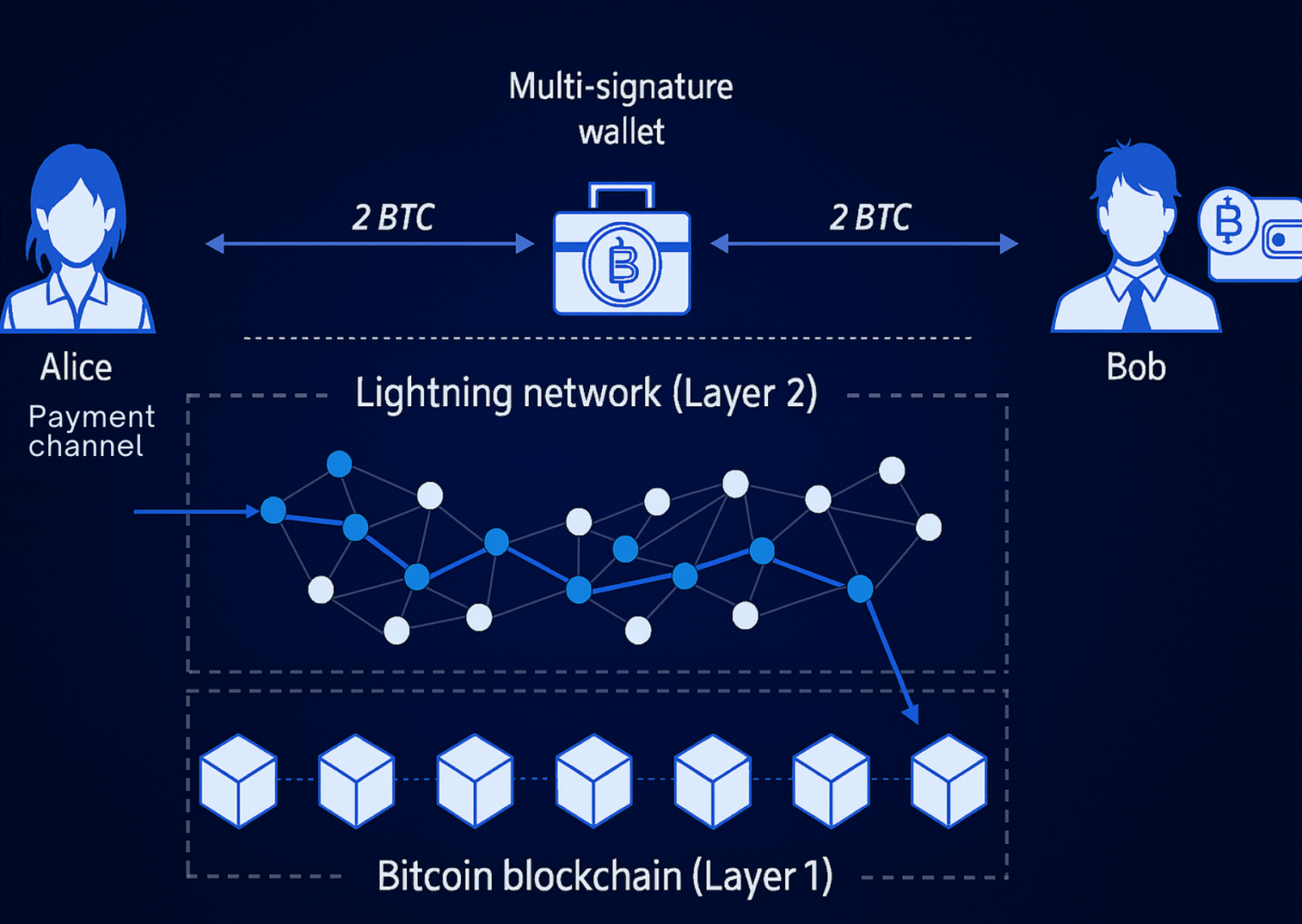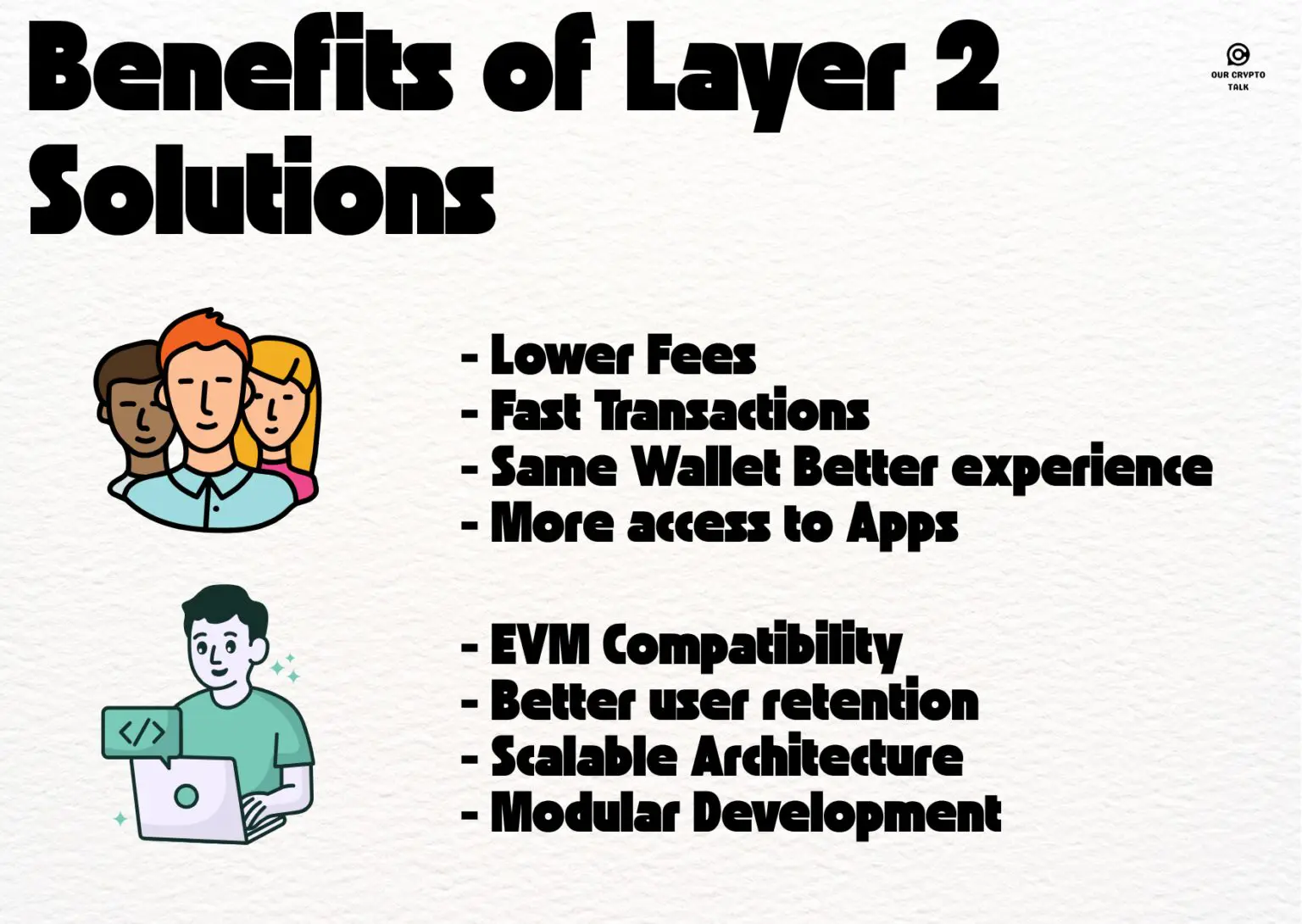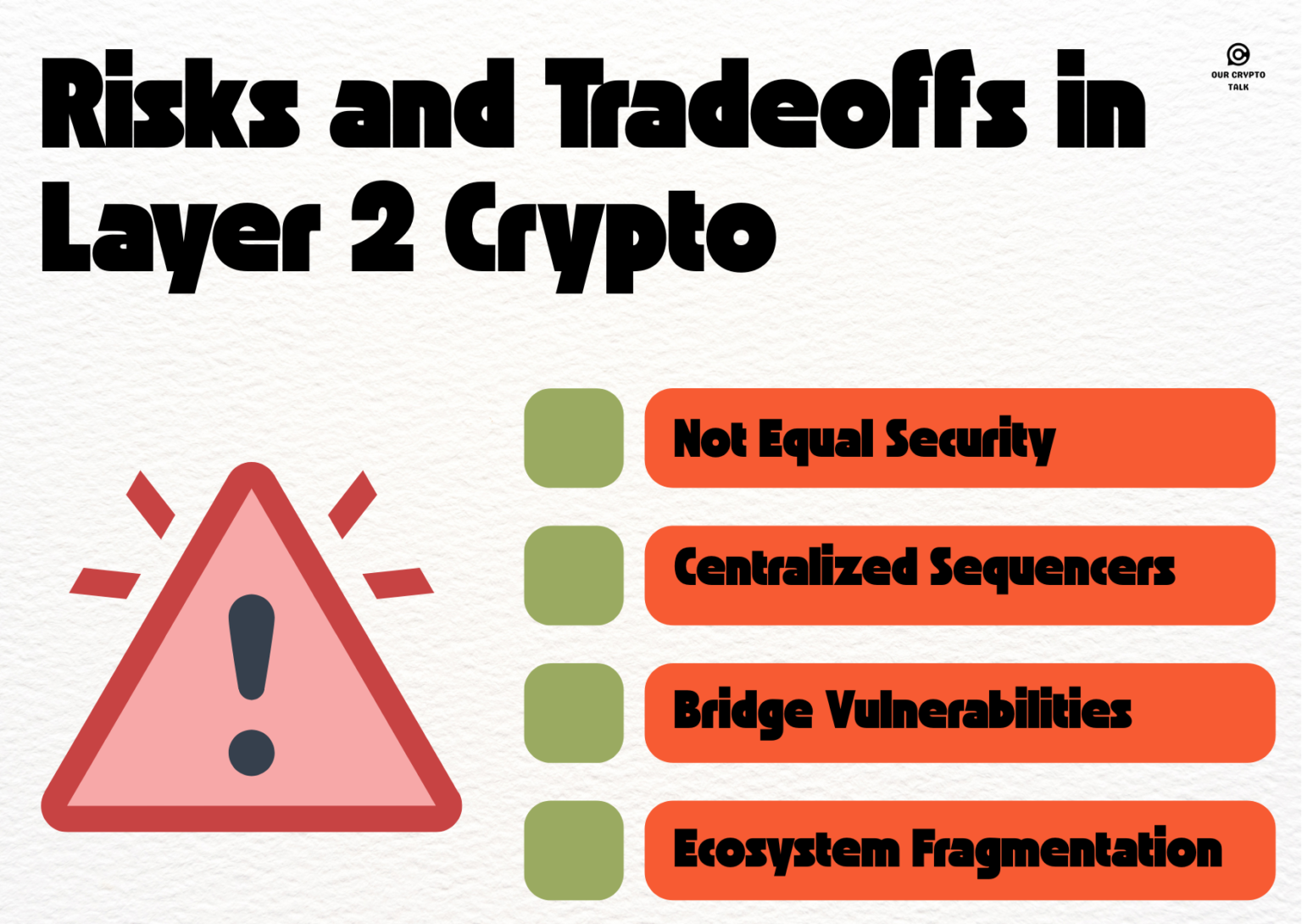
Layer 2 crypto solutions are transforming blockchain scalability. Explore top L2 projects, how they work, and why they’re crucial.
Author: Chirag Sharma
Published On: Mon, 21 Jul 2025 18:34:59 GMT
Layer 2 in blockchain technologies are designed to help blockchains scale without compromising their decentralization or crypto security. In simple terms, Layer 2 refers to protocols built on top of a Layer 1 blockchain. They take transactions off the main chain, process them more efficiently, and then settle the results back on the Layer 1. This approach allows thousands of transactions to be handled without clogging up the base network.
Think of it like a flyover road in a busy city. Instead of every vehicle being stuck in ground-level traffic, some are diverted onto the flyover, easing congestion and allowing everyone to move faster.
Some of the most common Layer 2 models include:
The real power of Layer 2 becomes obvious when you look at Ethereum’s gas fees. In 2021, during NFT and DeFi booms, users paid over $100 just to approve a single transaction. Today, thanks to L2s, that same transaction can cost a few cents and confirm in seconds.
Whether you’re minting NFTs, playing Web3 games, or sending cross-border payments, Layer 2 is making it all faster, cheaper, and more accessible.
The idea of scaling beyond Layer 1 isn’t new. The conversation started back in the early days of Bitcoin.
In 2015, Joseph Poon and Thaddeus Dryja proposed the Lightning Network, a Layer 2 solution for Bitcoin. Its goal was to move small transactions off the Bitcoin blockchain and only settle final outcomes on-chain. This allowed Bitcoin users to send and receive funds instantly, without waiting for block confirmations.

Ethereum’s path was similar but even more urgent. Vitalik Buterin, in his 2014 whitepaper, had already acknowledged the scalability problem. As Ethereum became home to ICOs, games, and DeFi protocols, the need for an off-chain solution became critical.
By 2017, developers introduced Plasma, which proposed the use of hierarchical chains that could operate independently but still anchor to Ethereum. Plasma laid the groundwork, but its complexity and data availability issues made it difficult to scale effectively. Still, it sparked the interest of many researchers and teams who would go on to build today’s rollups.
Another major influence was cryptography—especially zero-knowledge proofs ( ZK Proofs ), which had existed in academic circles since the 1980s. Blockchain researchers started adapting these tools to verify transactions without revealing all the underlying data.
Some important early milestones include:
In many ways, the birth of Layer 2 was a response to real-world pain points—network congestion, sky-high fees, and the inability of Layer 1s to keep up with user demand.
Let’s be honest—blockchains were not built for mass adoption in their original form.
Ethereum can handle around 15 to 30 transactions per second. Compare that with Visa’s 24,000 TPS, and the gap is clear. This limited capacity causes bottlenecks, especially during periods of high demand.
A few memorable moments that exposed these limitations:
These issues aren’t just annoyances—they limit the types of applications that can be built. Micropayments, on-chain gaming, and social platforms all become impractical when a single click costs as much as a meal.
Layer 2 solves these challenges by:
Without L2, the blockchain world would stay niche. With it, use cases like gaming, payments, and decentralized identity are finally able to thrive.
Here’s a breakdown of how L2 stacks up in solving real issues:
| Problem | Layer 1 Limitation | Layer 2 Solution |
|---|---|---|
| High Gas Fees | Costs can spike over $100 | L2s bring fees down to under $0.10 |
| Low Throughput | 15–30 TPS for Ethereum | L2s support thousands of TPS |
| Poor User Experience | Long wait times and failed txns | Near-instant finality and confirmations |
| Environmental Impact | PoW was energy-intensive | Most L2s operate on greener PoS infrastructure |
Layer 2 has evolved fast—from theoretical frameworks to robust infrastructure with billions in TVL (Total Value Locked). What started as state channels and sidechains has now expanded into advanced rollups, application-specific L2s, and modular solutions tailored for performance and security.
Let’s look at the journey:
Early efforts like Bitcoin’s Lightning Network and Ethereum’s Raiden Network introduced off-chain transaction channels. These were ideal for micro-payments but limited in scope. Channels worked well for two-party interactions but struggled with composability and complex smart contract use cases.
Plasma was one of the earliest Ethereum L2 designs. It enabled child chains that periodically submitted summaries to Ethereum. While the idea was solid, Plasma lacked proper data availability and required long withdrawal times. The concept eventually lost momentum, but it influenced today’s rollup architecture.
Sidechains like Polygon PoS and Gnosis Chain brought attention to alternative chains that could sync with Ethereum but rely on their own validators. These offered speed and low fees but were often criticized for weaker security.
The real breakthrough came with rollups. These compress hundreds of transactions and post a proof on Ethereum.
Each type has pros and cons. Optimistic rollups (like Arbitrum and Optimism) offer simplicity and EVM compatibility. ZK rollups (like zkSync and Starknet) bring efficiency and cryptographic rigor but are harder to build.
In 2024 and beyond, we’re seeing a shift toward app-specific rollups. Instead of competing on one shared L2, dApps now launch their own L2 chains using frameworks like OP Stack and zkStack. Coinbase’s Base, for example, is built on the OP Stack, while zkSync’s Hyperchains allow developers to deploy sovereign ZK-powered chains.
Layer 2 is no longer a one-size-fits-all solution. It’s now a design space with custom tooling, incentives, and governance models.
Here’s a quick overview of the major L2 players shaping the space. Each project tackles scalability in a unique way while serving different audiences.
| Project | Type | Launch Year | Key Features | Notable Use Cases |
|---|---|---|---|---|
| Arbitrum | Optimistic Rollup | 2021 | High EVM compatibility, strong adoption | GMX, Radiant, TreasureDAO |
| Optimism | Optimistic Rollup | 2021 | OP Stack modularity, retroactive rewards | Velodrome, Base (Coinbase chain) |
| zkSync Era | ZK Rollup | 2023 | zkEVM, native account abstraction | NFT platforms, payment rails |
| Starknet | ZK Rollup | 2022 | STARK proofs, Cairo smart contract language | dYdX (initially), real-time games |
| Polygon zkEVM | ZK Rollup | 2023 | Full EVM equivalence, part of Polygon ecosystem | DeFi, stablecoin rails |
| Linea | ZK Rollup | 2023 | zkEVM backed by ConsenSys | MetaMask integration, DeFi |
| Base | Optimistic Rollup | 2023 | Built by Coinbase, OP Stack architecture | Onboarding new users to crypto |
Arbitrum leads in TVL and ecosystem activity, but zkSync and Starknet are gaining momentum with superior cryptographic performance. Polygon continues to bridge the rollup and sidechain worlds with a cohesive ecosystem. And Base is onboarding millions thanks to Coinbase’s user base.
The Layer 2 race is heating up, but it’s not a zero-sum game. Multiple L2s can thrive by optimizing for different use cases—games, payments, identity, or high-frequency DeFi.
Layer 2 solutions offer real utility across the board. Whether you’re a casual user or a protocol developer, the benefits are hard to ignore.

Layer 2 is not just about speed and cost. It’s about unlocking new possibilities. Real-time blockchain games, pay-per-stream content, Web3 social platforms—none of these could function at scale without Layer 2 infrastructure.
Layer 2 scaling sounds like a perfect solution—but it’s not without compromises. Let’s break down the risks and tradeoffs users and builders should be aware of.

While rollups inherit Ethereum’s base-layer security, sidechains and some custom-built L2s often rely on their own validator sets or sequencers. If that infrastructure is poorly designed or malicious, user funds could be at risk.
Even rollups that anchor to Ethereum still rely on their own fraud or validity proof mechanisms. If those mechanisms fail (or are not fully decentralized), trust assumptions creep in.
Most Layer 2 Crypto platforms use a centralized sequencer to order transactions. This brings efficiency but creates a single point of failure. If the sequencer goes offline—or worse, acts maliciously—transaction ordering can be manipulated, or the network may temporarily stall.
While teams are working toward decentralizing sequencers, we’re not there yet. As of mid-2025, even top rollups like Optimism and zkSync still rely on a centralized setup.
To use Layer 2s, users often need to bridge assets between chains. Bridges are historically the most exploited part of the crypto stack. If a bridge gets hacked, user funds on Layer 2 can be drained even if the L2 itself remains secure.
Bridges introduce technical complexity and require users to manage cross-chain assets carefully. Some ecosystems, like Base and Polygon, are building native bridges to reduce this risk—but it’s far from eliminated.
With so many Layer 2s launching, liquidity and users are now spread thin. This fragmentation means apps often need to deploy on multiple L2s just to stay competitive. It also complicates things for users, who must juggle bridges, gas tokens, and wallet settings across chains.
Unified standards and cross-chain messaging protocols are improving, but fragmentation will likely get worse before it gets better.
The road ahead for Layer 2 Crypto is packed with momentum. Scaling Ethereum is no longer a dream—it’s already happening. But what’s next?
Teams are racing to solve the centralized sequencer problem. Optimism is exploring shared sequencer networks. zkSync is building towards a decentralized proof marketplace. Starknet is working on sequencer committees. These upgrades will make L2s more censorship-resistant and secure.
Expect new L2s in the future to launch with decentralized sequencing from day one.
Modular architecture is giving rise to shared ecosystems. The OP Stack, for example, allows multiple L2s like Base, Zora, and Mode to interoperate more easily. This shared tooling encourages a common standard, which could eventually lead to smoother cross-rollup UX.
Projects might stop competing on infrastructure and start competing on value—apps, incentives, and community strength.
We’re moving from monolithic L2s to application-specific rollups and even L3s. Think of L3 as rollups on top of rollups. These allow projects to define custom rules for privacy, performance, and governance.
Instead of launching on a public L2, a dApp might spin up its own mini-chain. It will still inherit Ethereum’s security but will have full flexibility over user experience and economics.
ZK rollups are likely to dominate the long-term future. They’re more secure, faster to withdraw, and better suited for privacy use cases. Once development tooling matures, ZK rollups may become the default scaling solution—not just for Ethereum, but for other chains as well.
That said, Optimistic rollups are evolving too, especially with faster fraud proofs and modular governance.
Layer 2 is a fundamental evolution in how we interact with blockchains.
Ethereum couldn’t serve the world with $40 fees and 10 TPS. But with rollups, app chains, and zk-powered L2s, we’re finally seeing real-world scalability. You can mint NFTs, trade, or play games without breaking the bank.
Still, it’s not a one-chain-to-rule-them-all scenario. In fact, fragmentation might increase as more custom chains pop up. But this isn’t necessarily bad. Just like the internet evolved into a network of interconnected services, the crypto space is becoming a modular mesh of app-specific systems that talk to each other.
So, where do we stand?
Layer 2 Crypto is no longer the future. It’s the present—and the gateway to everything Web3 wants to become.
Layer 2 Crypto solutions help Ethereum scale without compromising security
| Problem | Layer 1 Limitation | Layer 2 Solution |
|---|---|---|
| High Gas Fees | $50–$100 per txn | L2 fees under $0.10 |
| Low Throughput | 15–30 TPS | Thousands of TPS |
| Poor UX | Long wait & failed txns | Near-instant confirmations |
| Environmental Impact | PoW was energy-heavy | Most L2s run on PoS |


| Project | Type | Launch | Key Features | Notable Use Cases |
|---|---|---|---|---|
| Arbitrum | Optimistic Rollup | 2021 | High EVM compatibility | GMX, Radiant, TreasureDAO |
| Optimism | Optimistic Rollup | 2021 | OP Stack modularity | Velodrome, Base |
| zkSync Era | ZK Rollup | 2023 | zkEVM, account abstraction | NFTs, payments |
| Starknet | ZK Rollup | 2022 | STARK proofs, Cairo language | dYdX, gaming |
| Polygon zkEVM | ZK Rollup | 2023 | Full EVM equivalence | DeFi, stablecoins |
| Base | Optimistic Rollup | 2023 | Built by Coinbase | Onboarding new users |